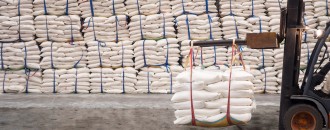
India emerged as fastest growing major economy in world: Finance Ministry
Source: PIB, Government of India
A press conference was held in New Delhi on Monday which was addressed by Ratan P Watal, Finance Secretary, Shaktikanta Das, Secretary, Department of Economic Affairs (DEA), Hasmukh Adhia, Revenue Secretary, and Arvind Subramanian, Chief Economic Adviser (CEA), Ministry of Finance among others. Following is the text of the brief Statement issued after the aforesaid Press Conference: As we complete, the first half of the current financial year 2015-16, it is time to step back and take stock of what we have achieved on the economic front, and what we need to do to consolidate the gains we have made. Despite the global slowdown and declining export demand, India has emerged as the fastest growing major economy in the world. While the government continues to implement its reform agenda, the economy should over time realize its 8% plus growth potential. With supportive policies in place, India is emerging as a strong growth driver for the world economy, capable of sustaining economic growth through its own momentum. Inflation has been decisively brought down: the headline CPI inflation is within the target zone, WPI inflation has been negative for ten consecutive months, and core inflation has shown signs of moderation too. The outlook for inflation is also good, as indicated by the RBI in its latest monetary policy review. Despite the uncertain monsoon, government food management, including use of the price stabilization fund to augment domestic supplies with imports, will ensure that food inflation is contained. The government and the RBI will work together to consolidate the gains achieved in inflation control, through the inflation targeting framework and the associated institutional arrangements. Our macro-fundamentals remain strong. The twin deficits, fiscal and current account, have been reduced. The government is committed to achieving this year’s fiscal deficit target as well as the fiscal glide path laid out in the budget. The Indian economy - based on a foundation of macro-economic stability, sizable foreign exchange reserves, and on creating the conditions for investment opportunities - is now better placed to handle external shocks. As a net oil importer, the global environment is also throwing up some opportunities for the Indian economy. To support the economy, RBI has already announced a 50 bps cut in the policy rate, bringing the cumulative support of monetary policy to 125 basis points this calendar year. This should boost confidence and investment, and help shore-up the corporate balance sheets. The government will play its part to ensure the benefits of accommodative monetary policy are transmitted to the economy at large. Through systematic work, we have been restructuring the expenditure side of the Budget over the last one year. While many commentators expressed doubt, we have simultaneously achieved 10% increase in tax devolution to the states, achieved over 30% increase in the plan cap-ex (Capital expenditure), and yet, adhered to the fiscal glide path outlined in the Budget. We continue to work together on rationalizing central sector schemes and programmes in run up to the Union Budget 2016-17. To give adequate time to the ministries/departments to reform their financial processes, this year the pre-budget exercise has been advanced by two months to ensure structural reforms on the expenditure side can be completed in time for the Union Budget 2016-17. On subsidy reforms- diesel, petrol and LPG now sell at market prices throughout the country. Consistent with its commitment to deregulation, the government has allowed two-way variability of petroleum pump prices. A cash subsidy is payable to LPG customers under the PAHAL scheme. Nutrient based subsidy regime has now stabilized for mixed (P&K) fertilizers and neem coating has been made mandatory for subsidized urea to check its diversion to industrial use. Digitisation and aadhaar seeding of Public Distribution System (PDS) is being pursued all over the country to lay the foundation for next generation of PDS reforms along the lines of the JAM trinity outlined in the Economic Survey 2015-16. Overall, expenditure on major subsidies as a percentage of GDP has come down from 2.5% of GDP in 2012-13 to 1.6% of GDP in 2015-16. While much progress has been made in the power sector over the last one and a half year, the financial health of discoms has received the highest attention of the government. We are working with the Power Ministry and the states to find a lasting solution to this problem, in a manner that ensures the gains of fiscal consolidation made over the 12th and 13th Finance Commission periods are maintained, while preparing a financial restructuring plan that incentivizes discoms to generate more revenues, and close the gap between average cost of supply and the revenues raised on sustained basis. The collection of direct and indirect taxes in the current year has been encouraging so far. If no other externality hits us, we are hopeful of achieving the total taxation target with possibility of a minor shortfall of around 5% within the total target of Rs.14.5 lakh crore. The tax collections figure can be taken as a positive index of growth in demand in the economy. We are trying hard to sort out legacy cases of tax demands raised retrospectively through mutually beneficial solutions. Our broad approach to taxation is as follows:
- Non-adversarial (less litigations)
- Lower tax burden and fewer exemptions
- Strengthening mechanisms for Advance Pricing Agreements, Authority for Advance Rulings and Settlement Commission
- Minimum direct interface of assesses with tax administration by using more and more, the facilities of e-filing, e-processing, e-refunds etc.
- Simplification of laws, rules and notifications.
The government has also taken some decisive steps in the past few months to support improvements in the functioning and profitability of Public Sector Banks (PSBs). The government has undertaken a set of reforms to address both systemic and governance issues, which include revamping the process of selection of directors on the boards of Public Sector Banks, laying of a road-map for a transparent and objective selection process for directors, separation of the post of non-executive Chairman and Managing Directors, etc. On the capital side, an assessment of capital requirements for the next four years has been made and a plan has been put in place to ensure that PSBs remain adequately capitalized. To improve accountability, a comprehensive framework has been put in place in which banks are required to achieve specified quantifiable targets. Pradhan Mantri Mudra Yojana (PMMY) aims to provide easier access to low cost credit through the formal banking system, to existing as well as new micro enterprises in the informal sector. The objective is to enhance livelihoods and mainstream borrowers by linking them with the banking system. Loans up to Rs.50 thousand, 5 lakh and 10 lakh may be advanced based on the micro- project's needs. From April 2015 till date, 43.55 lakh loans have been disbursed by banks, amounting to Rs.26,580 crore, with the sanctioned amount being Rs.28,496 crore. Loans are being extended at a rate of interest below 12%, without collateral requirements, and application formalities have been kept simple. The campaign was intensified in September, and the focus continues, with the objective of creating a more supportive climate for self-employment. Infrastructure spending has picked-up on the back of accelerated government spending on highways, railways and the power sector. As already mentioned, the plan cap-eX has increased by over 30% this year. This is beginning to crowd-in private investment, and the public private partnership projects which had stalled are also now picking up. We are in the process of setting-up a National Infrastructure Investment Fund (NIIF) that will channelize both domestic and foreign resources to satisfy the infrastructure needs of our economy. To summarize, our macro-fundamentals remain strong. We are now better placed to handle unforeseen external shocks, and to put India firmly on the path of economic recovery and inclusive prosperity.






 to success.
to success.